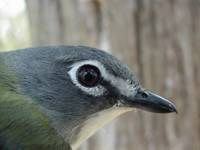 HOME: www.hiltonpond.org |
|||
|
THIS WEEK at HILTON POND |
|
BUFFALO BIRDS Everyone is familiar with ectoparasites such as ticks that attach to our skin and suck our blood, or of endoparasites such as tapeworms that hook onto our intestinal walls and absorb food we've digested but not absorbed. (There are certainly ticks aplenty in summer at Hilton Pond Center, but we hope none of the local humans are infested by tapeworms!) 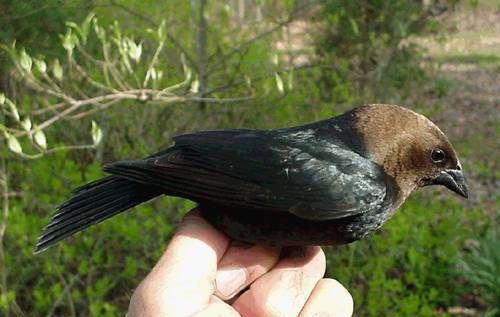
All photos © Hilton Pond Center Less familiar than external and internal parasites are organisms called "social parasites," which may, for example, alter the way a family unit functions. One well-known social parasite is the European Cuckoo, which lays its eggs in the nests of other birds and leaves its offspring to be cared for by foster parents of a different species. The baby cuckoo actually flips its nestmates from the nest, eliminating competition and gaining full attention from the host birds. Many species are known to lay an occasional egg in another bird's nest, but the cuckoo has no choice and is an "obligate" social parasite.
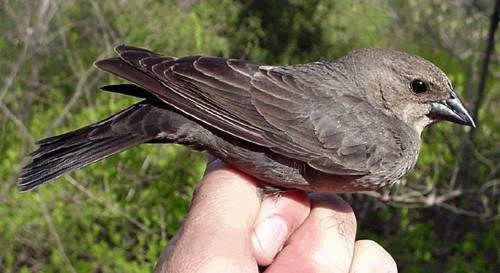 Once a female (above) is fertilized, she scouts an area, watching for other bird species as they build nests or incubate eggs. Then, when a potential host bird leaves a nest to stretch her wings, the female cowbird sneaks in and adds an egg of her own to the existing clutch, often removing one host bird's egg. Historically, some Brown-headed Cowbirds lived in the Carolinas, but the largest concentrations probably occurred in the Great Plains and might more appropriately be called "Buffalo Birds." Some ornithologists speculate cowbirds followed American Bison, Bison bison, and ate insects they stirred up; since these cowbirds were constantly wandering, they had no time to settle down; only those that laid eggs in other birds' nests were able to pass on their genes--genes that eventually stopped carrying the code for nest-building.
To make matters worse for a whole new assortment of songbirds, researchers have found that Brown-headed Cowbirds can be very fecund. An female cowbird can lay an egg a day for ten days, take a break for her ovaries to recycle, lay another series of ten eggs, and then repeat the process one more time. That's up to 30 eggs laid and up to 30 nests parasitized in a single season by just one female Brown-headed Cowbird! Today, at least 150 species of North American birds are known to be parasitized by Brown-headed Cowbirds. It's little wonder some of these are threatened or endangered species that--when we add human-induced habitat destruction to the mix--can ill-afford competition from the Buffalo Bird, a "native" species that is superbly adapted as a social parasite. If you enjoy "This Week at Hilton Pond," please help Support Hilton Pond Center for Piedmont Natural History |
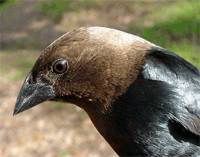 A similar situation occurs across North America with Brown-headed Cowbirds, members of the Blackbird Family (Icteridae) that includes species such as Rusty Blackbirds, Common Grackles, and Red-winged Blackbirds. In winter, cowbirds often join other blackbirds in large flocks, moving through farmland and suburbia foraging on the ground for nuts, seeds, and invertebrates. As spring arrives, cowbird behavior changes dramatically. Females become elusive, while males (top, and above right) hang out in conspicuous small groups--vigorously displaying and calling to compete for a female's attention. Both sexes are promiscuous, never forming a pair bond for much longer than it takes for the mating act to occur.
A similar situation occurs across North America with Brown-headed Cowbirds, members of the Blackbird Family (Icteridae) that includes species such as Rusty Blackbirds, Common Grackles, and Red-winged Blackbirds. In winter, cowbirds often join other blackbirds in large flocks, moving through farmland and suburbia foraging on the ground for nuts, seeds, and invertebrates. As spring arrives, cowbird behavior changes dramatically. Females become elusive, while males (top, and above right) hang out in conspicuous small groups--vigorously displaying and calling to compete for a female's attention. Both sexes are promiscuous, never forming a pair bond for much longer than it takes for the mating act to occur. Some species--Blue Jays and Northern Mockingbirds, for example--may recognize the interloper's speckled egg (left) and remove it from their nests. (Cowbird eggs may have a bluish, cream, or white background color.) Most other birds simply continue incubating, but some quickly desert a nest in which an unfamiliar egg is deposited. Unlike the European Cuckoo, a cowbird baby only occasionally kicks out its unrelated nestmates (or eggs), but it usually hatches sooner and develops more quickly than offspring of the host birds. As such, it starts begging and leaves the nest sooner, all of which distracts the foster parents from feeding their own nestlings and fledglings.
Some species--Blue Jays and Northern Mockingbirds, for example--may recognize the interloper's speckled egg (left) and remove it from their nests. (Cowbird eggs may have a bluish, cream, or white background color.) Most other birds simply continue incubating, but some quickly desert a nest in which an unfamiliar egg is deposited. Unlike the European Cuckoo, a cowbird baby only occasionally kicks out its unrelated nestmates (or eggs), but it usually hatches sooner and develops more quickly than offspring of the host birds. As such, it starts begging and leaves the nest sooner, all of which distracts the foster parents from feeding their own nestlings and fledglings.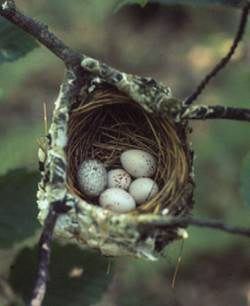 Cowbirds have been social parasites for thousands of years but pose problems today for more kinds of birds over a much wider area. When early settlers and converted woodlands to cow pastures, they created corridors through which larger numbers of cowbirds moved east and began parasitizing new species--even those that breed in forests, such as the Blue-headed Vireo (nest photo at right, bird photo below). Cowbirds still prefer to lay their eggs in nests in open areas, but will penetrate woods a quarter mile--meaning that a forest must be more than half a mile wide to deter these social parasites. Even though Hilton Pond Center is a nature reserve and has plenty of trees, its 11 acres are surrounded by open lawns and grazeland, so it is easily invaded by female cowbirds.
Cowbirds have been social parasites for thousands of years but pose problems today for more kinds of birds over a much wider area. When early settlers and converted woodlands to cow pastures, they created corridors through which larger numbers of cowbirds moved east and began parasitizing new species--even those that breed in forests, such as the Blue-headed Vireo (nest photo at right, bird photo below). Cowbirds still prefer to lay their eggs in nests in open areas, but will penetrate woods a quarter mile--meaning that a forest must be more than half a mile wide to deter these social parasites. Even though Hilton Pond Center is a nature reserve and has plenty of trees, its 11 acres are surrounded by open lawns and grazeland, so it is easily invaded by female cowbirds.